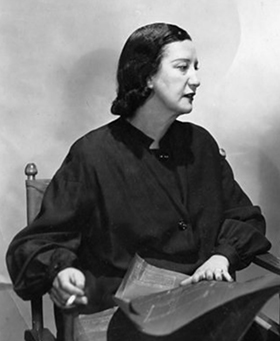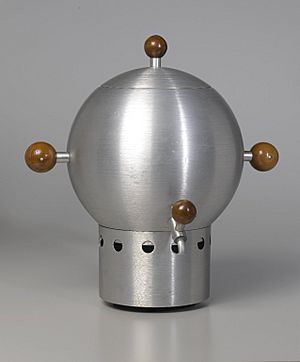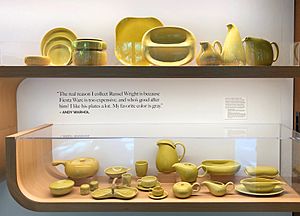Mary Wright (designer) facts for kids
Quick facts for kids
Mary Wright
|
|
|---|---|

Wright in the 1940s
|
|
| Born |
Mary Small Einstein
December 13, 1904 New York City, US
|
| Died | September 15, 1952 (aged 47) New York City, US
|
| Education |
|
| Known for | Industrial and product design; marketing |
|
Notable work
|
Wright Accessories; American Modern |
| Style | American modernism |
| Spouse(s) | |
Mary Small Einstein Wright (born December 13, 1904 – died September 15, 1952) was an American designer, artist, writer, and businesswoman. She helped create the "modern American lifestyle" through her work. Mary and her husband, Russel Wright, started a design company called Wright Accessories Inc. She was in charge of factory work, advertising, and sales.
Mary Wright also helped start America Designs Inc., a group that supported American industrial designers. She co-wrote a popular book called Guide to Easier Living. This book suggested that making life easier was like solving "engineering problems" with "scientific solutions."
Contents
Early Life and Education
Mary Wright was born in Manhattan, New York, in 1904. Her family was well-off and owned textile mills. Her father, Milton I.D. Einstein, led a lace mill company. Her mother was Alma Stix Einstein. Mary was also a relative of the famous scientist Albert Einstein.
Mary studied sculpture with a modern artist named Alexander Archipenko. She went to the Ethical Culture School in Manhattan. Later, she attended Cornell University.
Designing for the American Home
In 1929, Mary and Russel Wright started their design business, Wright Accessories Inc. Mary was the vice-president and managed the factory. She also handled all the advertising and sales. They set up their studio in a former stable in New York City.
Their company made casual serving items from materials like spun aluminum and wood. Mary turned their studio into a small metal factory to produce the Spun Aluminum line. She created many ads and wrote the words for them. The company also made small metal animal figures. Mary encouraged Russel to become a well-known industrial designer.
In 1935, Mary Wright came up with the word "blond." She used it to describe the light-colored maple wood used in their furniture and accessories.
In 1936, Mary and Russel Wright teamed up with Irving Richards. They started the Raymor Company, and Mary was a part-owner. Mary and Richards wrote a guide on how to market and advertise products.
The American Modern Collection
The American Modern line was one of the Wrights' most successful products. It was a collection of dishware designed for everyday use. It first came out in 1939. By 1959, over 200 million pieces had been sold!
The Wrights' designs were simple and friendly. Their smart marketing helped them build a huge business that changed American homes. They made ideas like open-plan rooms and outdoor living very popular.
Mary Wright worked with her husband to design modern tableware. She managed the business side and was in charge of selling their products. This included furniture and dinnerware. She also created special displays in department stores. These displays showed how their home designs fit into a relaxed American lifestyle.
Mary Wright helped found America Designs Inc. and was its secretary. This group supported the work of American industrial designers. In 1940, Mary and Russel Wright launched a big marketing program called American Way. They did this with help from Eleanor Roosevelt at Macy's department store in New York. The American Way program aimed to sell original designs by American artists and designers to many people across the country.
Country Gardens Dinnerware
In 1946, Mary Wright created her own dinnerware collection called Country Gardens. It was inspired by Asian designs. This collection was made for the Bauer Pottery Company. The dishes were made of earthenware and had mottled glazes in green, pink, brown, beige, and white. They were even shown at the Museum of Modern Art. Mary developed her own glazes with help from Doris Coutant.
Guide to Easier Living
Mary Wright co-wrote the popular book Guide to Easier Living (1950) with Russel Wright. This book was like their main idea for how people should live. It explained ways to have more free time and less housework. This could be done through smart design and managing time well. The main idea of the book was that "formality is not necessary for beauty."
In a chapter called The Housewife-Engineer, the authors told readers to study everyday tasks. This included making beds, peeling potatoes, and cleaning the house. They wrote that a home is like a "small industry." They said every housewife is like its "production engineer." The book suggested that choices about how you live were like "engineering problems with scientific solutions." It even had a chart showing 32 steps for "scientific bedmaking."
The book offered modern ways of living for middle-class families. This included ideas like open plan living and easy ways to entertain guests. The Wrights suggested ways to spend less time on hard chores like cooking and cleaning. This would leave more free time to spend together. Mary Wright's ideas in this helpful guide matched the shift from city to suburban living after World War II.
Personal Life
Mary Wright married the American industrial designer Russel Wright in 1927. They got married in Woodstock, New York. Both were involved in the Maverick Festival and artist colony there. Russel designed and directed, and Mary studied sculpture.
The couple lived in a large apartment in New York City. They also spent time at their 80-acre property, Dragon Rock at Manitoga, in Garrison, New York. The Wrights bought the Manitoga property in 1942.
Mary and Russel Wright adopted a daughter named Annie. Mary Wright passed away from cancer in 1952, at the age of 47. Her daughter Annie was 2 years old at the time. Annie was raised by her father.
Legacy
In 2021, the Russel and Mary Wright Design Gallery was opened at Manitoga in New York. This gallery shows how the "Wrights shaped modern American lifestyle" through their designs.




